The Internet of Things (IoT) is changing our daily lives faster than we can imagine. According to a report by Mordor Intelligence, the IoT market is expected to grow at a CAGR of 10.53% to reach $1.39 trillion by 2026, from $761.4 billion in 2020.
Sectors like automotive and transportation, energy and utilities, and manufacturing are adopting the IoT at a quick pace. However, new IoT adopters often overlook device and cloud network management.
Consistent management of the connected IoT devices is essential to ensure reliable cloud analytics for making business decisions. Several vendors have launched platforms to help businesses with IoT device management. Some of the best platforms are discussed here.
What Is IoT Device Management?
An IoT device is a physical device embedded with sensors that can transmit processed data to other systems and devices over a network. IoT device management is a process that involves onboarding (setting up, authenticating, configuring), monitoring, diagnosing and managing such connected devices at scale.
Once a new device is registered and its identity is verified, administrators configure necessary attributes and other settings like security. Based on the data analysis while monitoring an IoT device, admins can perform necessary actions like troubleshooting issues and performing firmware updates. You can also analyze data for predictive insights and better decision making.
What is IoT Device Management Platform?
IoT device management platforms unify and simplify the remote management of IoT devices. These platforms enable businesses to work with different IoT devices from different vendors across geographical locations.
You can automate most of the IoT device management tasks; from provisioning devices to their monitoring, diagnosis and maintenance, sometimes even without much coding knowledge.
The main benefit of any proprietary or open-source IoT device management platform is that it is easy to remotely scale the IoT ecosystem. It also ensures the security of individual devices to prevent data breaches.
How Does IoT Device Management Platforms Work?
An IoT device management platform enables device onboarding, management of devices and the analysis of transmitted data.
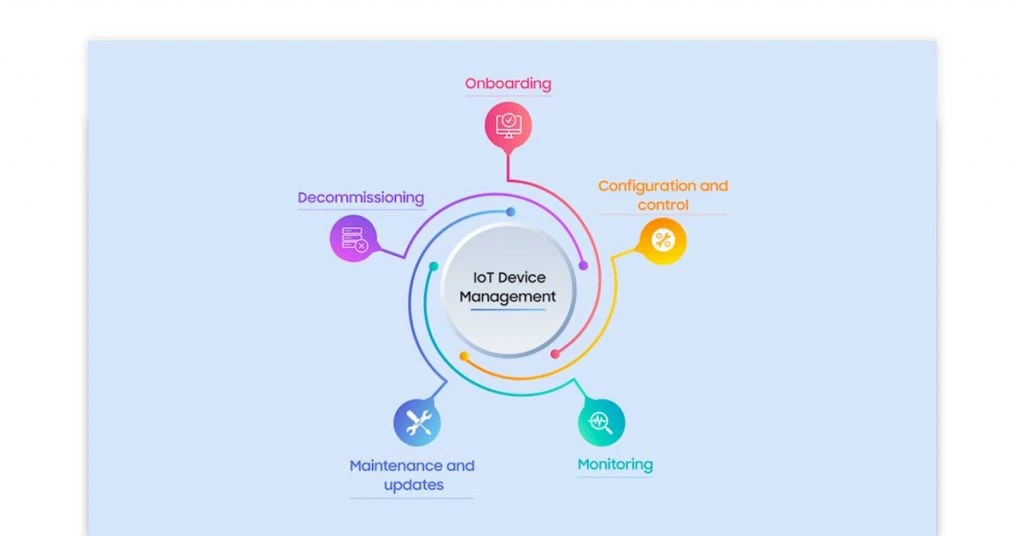
- Device Onboarding
To onboard an IoT device for connecting to the web, it first needs to be registered. Depending on the choice of remote IoT device management platforms, users can register individual devices or in bulk. The device registered can be physical or its logical representation.
You must include policy documentation stating how the device can send and receive data for configuration and provisioning. Once the IoT device is authenticated and settings are modified as per the requirement, it can start sending and receiving data.
- Data Transmission
Depending on factors like connection speed, connection range, and device power consumption, the selection of communication methods for data transmission varies. IoT devices use MQTT and HTTP protocols to send and receive data in real time.
MQTT is better for low bandwidth and data volume. HTTP is ideal for sending large amounts of data over the web. If an IoT device is not functioning correctly, the platform alerts the user.
- Data Analysis
IoT device management platforms enable users to define workflow based on the data received. This way, necessary actions can be performed automatically. The platform monitors the devices to ensure that data is being sent for analysis continuously.
Many IoT device management platforms even provide graphs and other ways to visualize data better and make decisions.
IoT Device Management Features
- Bulk onboarding
Multiple devices must be registered and authenticated remotely via their network key and identification credentials. You must ensure a secure connection between the registered IoT devices and the IoT service. You can then configure the devices with a few simple steps in the management dashboard.
- Create a hierarchy of devices
You can categorize devices based on their security requirements, functionalities or other attributes. The groups of devices can be further organized into a hierarchy to manage access policies, perform actions, and view metrics at once. You can also offboard devices that no longer fit the criteria defined by you.
- Analytics and reporting
Users receive real-time insights based on data received from different devices. You can also view reports for a fleet of IoT devices for better decision making.
- Troubleshooting
IoT device management includes support for remote troubleshooting to resolve issues across multiple endpoints. It helps avoid manual work in resolving each issue individually.
- Integrations
Connecting with other systems is vital for automating actions and integrated workflows. There must be compatibility with the existing hardware and application software.
Reasons You Need IoT Device Management Platform
IoT device management platforms can help your business in the following ways.

- Faster time to market at lower costs
An IoT device management platform enables automation of device administration tasks and other useful features like application templates that decrease development and testing time. The software helps in the faster rollout of large-scale deployments.
- Secure onboarding and offboarding
The platform ensures that only authorized devices are connected to the network to establish a secure communication channel. Each device is registered and attached via network keys and credentials to its base station. You can remotely onboard the devices and remove them via the platform dashboard without physically going to the device location.
- Boost cyber security
The risk of cyber-attacks is biggest concerns of businesses while building IoT applications. An IoT network and device management platform enables users to send over the air updates for fixing vulnerabilities and bugs. Also, instant alerts help take immediate action against the cause of any anomaly in the network.
- Improved network monitoring and troubleshooting
A remote IoT device management platform provides complete visibility into network traffic, registered devices, and current status. You can quickly diagnose unexpected issues through access to real-time data from individual devices.
It ensures a practical approach to troubleshooting issues in geographically dispersed edge devices at scale. You can also schedule the maintenance for multiple devices at once.
- Simpler integrations and better scalability
An IoT device management platform helps in easier integration through REST APIs. It helps in scaling applications as per business needs. You can view all the integrations from one interface, which simplifies their management.
Top 10 IoT Device Management Platforms in 2026
- AWS IoT Device Management
- Azure IoT Hub
- Cloud IoT Core
- IBM Watson IoT Platform
- Oracle IoT Cloud Service
- Datadog
- Particle
- Azure IoT Central
- Upswift from JFrog
- Losant
Some of the best IoT device management platforms available in the market worldwide are discussed next.
AWS IoT Device Management
IoT device management platform by Amazon Web Services (AWS) offers a cloud-based service to securely register, organize, monitor, and manage IoT devices remotely. These devices can include cameras, vehicles, appliances, machines, etc.
The platform integrates with AWS IoT core to connect devices and the cloud for remote management. It also makes security improvements based on alerts sent by the IoT device defender.
Pricing: The IoT management platform works on a ‘pay for what you use’ pricing model. Depending on the number of devices, there is separate billing for bulk device registrations, remote actions like updates, index updates, and queries for fleet index.
- Operating system & device type agnostic
- Quickly locate connected devices based on device state, device ID, type, etc.
- Remote execution of factory resets, updates (OTA), reboots, and security patches
- Hierarchy creation for groups of devices and sensors for easy management
- Initial set up can be difficult
- Steep learning curve
Azure IoT Hub
Azure IoT Hub is a cloud-hosted service that works as a central message hub to communicate bidirectionally between IoT applications and the managed connected devices. You can track device authentication, connections, and failures.
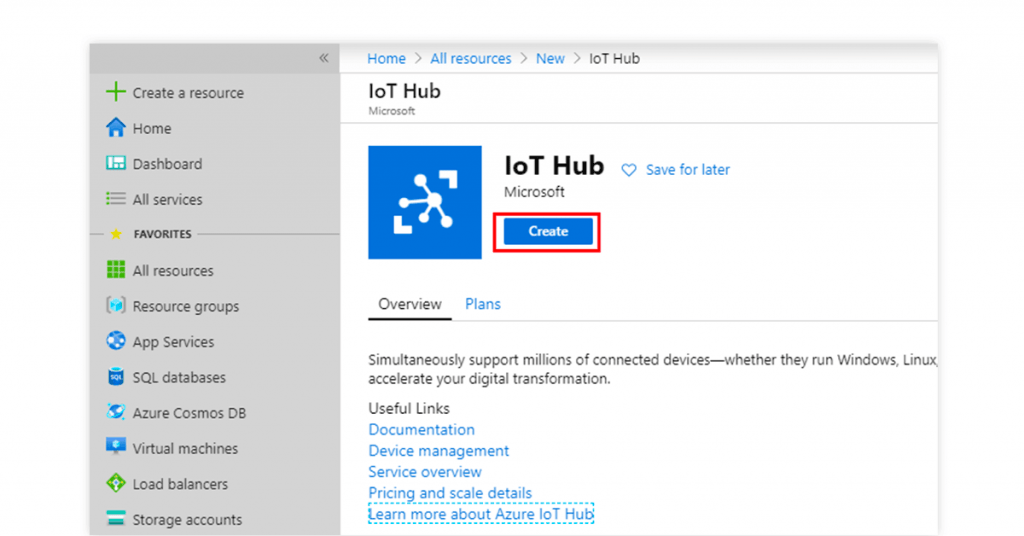
In cloud-to-device messages, you can send and track commands and notifications. On the other hand, device-to-cloud telemetry data can help you understand the device state. You can also define message routes to other Azure services without programming.
Pricing: The free edition allows users to register up to 500 device identities and transmit up to 8,000 messages per day. Paid plans come in Basic and Standard tiers.
Pricing in the Basic tier starts at INR 1,041.56 for up to 4,00,000 messages/day/ IoT Hub unit. The default limit on IoT Hubs per subscription is 50. You can also request a custom pricing quote.
- Easy implementation and good documentation
- Integrates with other Azure services like Logic Apps, Stream Analytics, Machine Learning, Event Grid to create comprehensive solutions
- Individual identity set up and authentication for each device to ensure confidentiality and revoke access rights when needed
- Can connect to devices via Azure IoT Plug and Play conventions, SDK libraries, and more
- Compatibility with Azure Stack for creating hybrid IoT apps
- Could have better hardware integration capabilities
Cloud IoT Core
Google’s Cloud IoT Core is a completely managed service to connect, manage, and collect IoT data from devices. You can use REST APIs to automatically manage the registration, deployment, and operation of numerous devices.
The IoT platform device management process also includes sending commands and configuration directives to these connected devices. Resource-constrained devices can use a gateway to communicate with the platform, even offline.
Pricing: Pricing is based on the data exchanged between IoT Core and devices. Initial 250MB comes under the free tier. Standard tier pricing starts at INR 0.34/ MB for 250MB to 250GB data volume per month.
- CA-signed certificates, asymmetric key authentication over TLS 1.2 for security.
- No up-front software installation; automatic load balancing and horizontal scaling
- Integration with Google Big data analytics and ML services such as Cloud Bigtable, Cloud Dataflow, Google Data Studio, and more for insights
- Can connect to devices via Azure IoT Plug and Play conventions, SDK libraries, and more
- Stackdriver monitoring and logging to monitor device metrics and view connection/ error logs
- A steep learning curve
- Lack of support for user-defined functions
IBM Watson IoT Platform
IBM Watson IoT platform enables users to add/ remove devices in bulk, monitor usage, update/ reboot firmware, and more. You can access historical and real-time data from devices through web console dashboards with IoT platform device management.
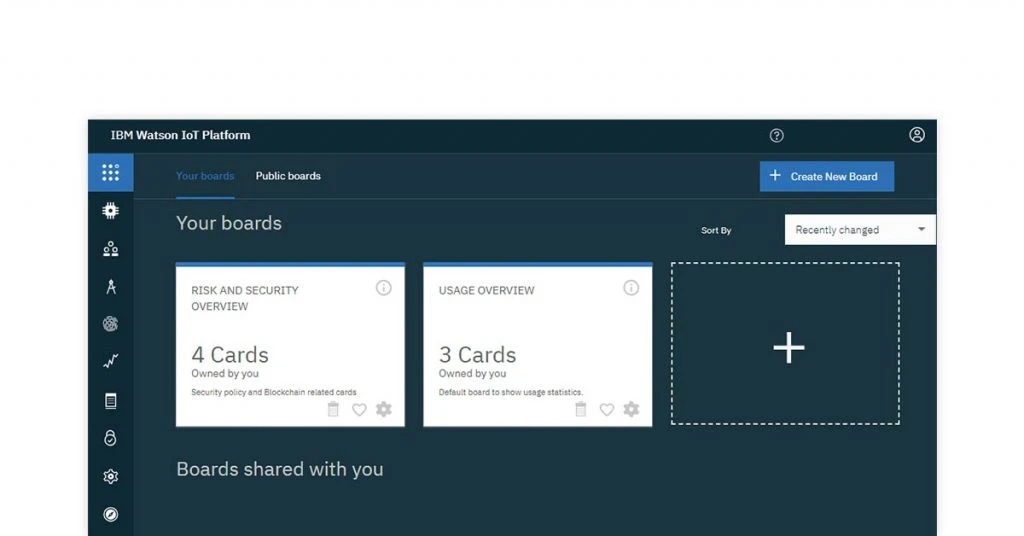
You can also send commands to devices via MQTT protocol with TLS for secure communication.
Pricing: There is a free Lite plan with up to 500 registered devices and 200 MB each of data exchanged and analysed every month. Paid plans include Connection and Analytics Service – Capacity 1 and Capacity 2. Customers are billed based on usage.
- Rest and real-time APIs to connect data from devices to other apps
- Access control and threat intelligence to visualize critical risks
- Trigger automatic actions based on the severity of conditions, including IFTTT, emails, alerts, etc.
- Scalable storage and data lifecycle management with IBM Cloud Object Storage
- Could improve billing and admin tools
- Official documentation could have more examples for better understanding
Oracle IoT Cloud Service
Oracle IoT Cloud Service enables users to connect their devices to the cloud and analyze the collected data in real-time. Whether you want to monitor assets, production, vehicles and trips, or work environment, you can choose a relevant solution. Data insights help in automating actions and diagnosing issues to follow relevant fixes.
Pricing: Pricing for Oracle IoT intelligent applications is available on request. It is a part of the Cloud Applications offering.
- Individual or batch registration of devices
- Creation and alteration of device policies without any coding
- Integrates with external services and enterprise applications
- Verify integration connectivity feature to ensure a connection between integration target and IoT Cloud Service.
- A complex management console
- Integration with other services could be better
Datadog
Datadog IoT monitoring solution enables businesses to keep up with device hardware metrics, software and network performance, application logs, and other important data.

You can also analyze other custom business metrics by changing the code. It uses machine learning (ML) algorithms to detect anomalies and unusual technical occurrences.
Pricing: The IoT management platform offers a free trial. There is a free plan without anomaly detection and forecast monitoring. Pricing starts at INR 1137.98 per host per month. For on-premise network devices, monitoring starts at INR 531.06 per device per month.
- Supports several platforms like Windows, Linux, Android, and ARM devices
- No extensive set up or configurations
- View data graphs and alerts for any set of devices by grouping, based on user-specified tags
- Customizable alerts for handling large-scale and long-term device failures.
- Data visualization of IoT devices running on cloud services like Azure IoT Hub and Google Cloud IoT
- Confusing UI
Particle
Particle IoT device management platform enables users to register, manage, and operate all their devices from a single interface. After developing the product, you can remotely fix bugs and send over-the-air (OTA) software updates.
There are filters and modifier tools to view data of different devices quickly. For security, the platform offers edge-to-cloud encryption and multi-factor authentication.
Pricing: You can sign up for an account. There is a free plan with 100K data operations per month for up to 100 devices. With technical support, paid options include Growth and Enterprise plans.
The Growth plan starts at INR 7511.18 per month for every 720K data operations and additional 100 devices. Enterprise pricing is available on request.
- Fleet Health Dashboard to monitor critical metrics and get advanced analytics
- Manage billing with a simple interface
- Geolocation mapping interface to monitor all asset tracking related devices
- Webhooks and integrations to share data with third-party services and endpoints
- Insufficient documentation
- Difficult to start and maintain operations without interruptions from other devices like remote-controlled objects.
Azure IoT Central
Azure IoT Central enables quick connectivity between IoT devices and the cloud to develop enterprise-grade IoT solutions. The IoT device management software offers industry-specific templates and Azure certified devices catalogs to build IoT applications quickly.
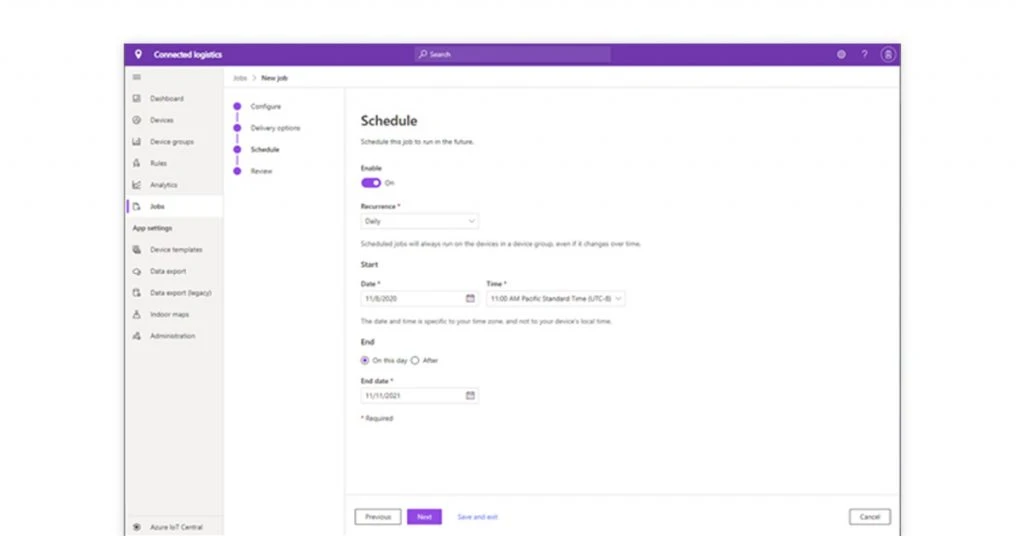
You can easily update, fix, and reconfigure your devices with centralized device management.
Pricing: It offers a 7-day free trial. There are three pricing tiers- Standard Tier 0, Standard Tier 1, and Standard Tier 2. The first two active devices are free for message volumes up to 800 (Tier 0), 10,000 (Tier 1), and 60,000 (Tier 2) per month.
Pricing starts at INR 6.07 per month for additional devices and INR 5.31/1K for additional messages. You can also request a pricing quote.
- Open modelling language to make development faster and simpler
- ‘Organizations’ feature for multi-tenant scalability
- Managed access to users and devices
- Customizable IoT solution design
- Microsoft AppSource Marketplace to publish your solution and monetize it.
- Can add support for more operating systems
- Additions to official documentation needed
Upswift from JFrog
Upswift Linux and IoT device management platform provides complete visibility into a hierarchy of device groups with details like real-time resource usage, current connection state, and more.
By installing the Upswift agent once, you can quickly integrate it with numerous IoT devices for remote access and 24/7 management, even offline. The platform informs users of any security issue, anomaly, or error via instant alerts to debug and fix the issue.
Pricing: There is a free prototype plan that includes three devices. Depending on the project scale and use, pricing starts at INR 7517.02 for the early production plan.
- Smart registration method to automatically recognize a new device, including duplicated images
- Remote monitoring and control, software updates, resolving issues for devices
- Permission-based access and SMS based two-factor authentication for account security
- In-built tools for 24/7 security of edge devices in one click
- No option for REST API based integration and team accounts in free/basic plan.
Losant
Losant IoT cloud platform enables businesses to build personalized IoT services, products, and applications without writing a lot of code. The IoT device management software has a drag-and-drop visual workflow engine that helps create complex IoT solutions quickly.
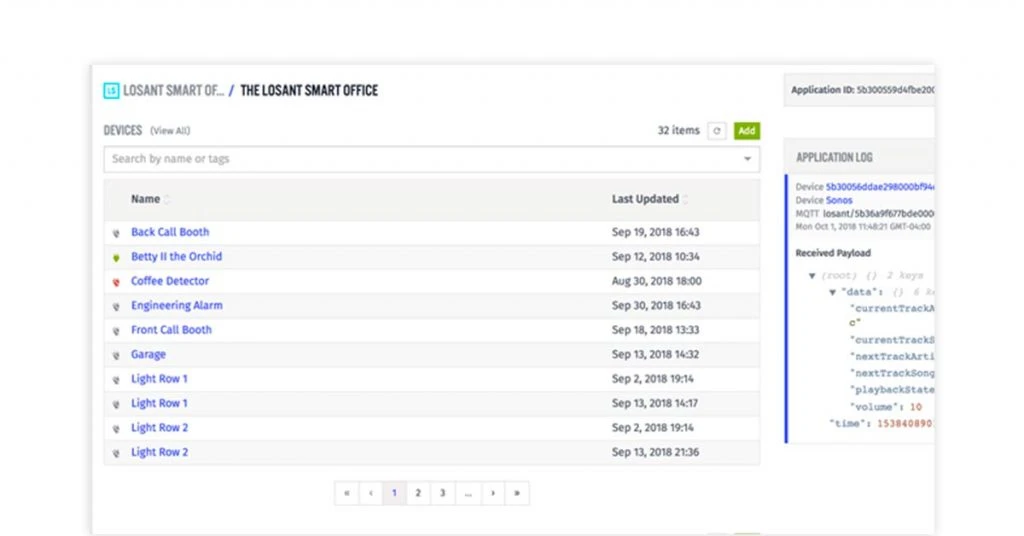
With its data graphs, logs, and maps, you can easily visualize information to make the right decisions. Its applications include industrial equipment monitoring, asset tracking, and smart environment.
Pricing: Losant offers a free plan without collaboration features. It offers a 60-day free trial for paid plans. Pricing for professional and enterprise licenses is available on request.
- Permission-based access, encryption, and third-party audits for security
- Application templates to build IoT products faster, taking actual implementations as reference
- IoT components can work with popular cloud vendors like MS Azure, AWS, Google Cloud Platform, etc.
- Easy segmentation of data and devices between any number of users
- Lacks dedicated 24/7 support in free and professional license version
Conclusion
Selecting a suitable IoT device management platform is crucial for the success of your IoT deployment in the long run. If you do not want a proprietary solution, you can also start with an open-source IoT device management platform. Carefully analyze the pros and cons of each IoT device management platform before making your decision.
Related Categories: Website Development Tools | Ecommerce Website Builder | Web Hosting Solutions | App Development Software | Application Lifecycle Management Software
Ayushee is currently pursuing MBA Business Analytics from SCMHRD, Pune with a strong background in Electronics and Communication Engineering from IGDTUW. She has 2 plus years of full-time work experience as an SEO content writer and a Technology Journalist with a keen interest the amalgamation of business and... Read more
















